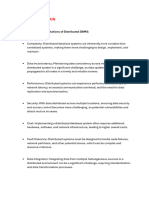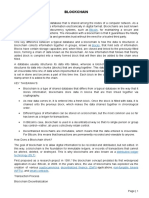Professional Certification Program in
Blockchain
Powered by
� Introduction to Blockchain
Powered by
� Learning Objectives
By the end of this lesson, you will be able to:
Identify present business challenges
Analyze ledger system and peer-to-peer networks
Classify centralized, distributed, and decentralized systems
Identify the components of a Blockchain
Powered by
� Challenges Faced by Modern Businesses
Powered by
� Challenges Faced by Modern Businesses
Blockchain can help tackle the following business challenges:
Lack of Trust No Transparency Mediator Charges
Manual Processes Information Security
Powered by
� Lack of Trust
● In business, two or more untrusted parties might need to interact with each other or
transact in an untrusted medium.
● Hence a mechanism was required where people could do business with untrusted
parties.
Powered by
� Lack of Transparency
● Most organisations keep their data/systems private and this hinders their transparency.
● Lack of transparency eventually leads to lack of trust, which can stunt their growth.
Powered by
� Mediator Charges
● Mediators, also referred to as middle-men, form a crucial part of business today.
● They help various parties reach an agreement, but their drawback is that they charge
a hefty fee.
Powered by
� Manual Processes
● Though we live in the digital age, most of our important procedures such as property registration
and census registration are still manual.
● Manual procedures are error prone due to human intervention.
● This can be avoided using a neatly designed computer system.
Powered by
� Information Security
● Information/Data is an asset to business.
● Loss or leak of such data can lead to losing money and reputation.
Powered by
� What is Blockchain?
Powered by
� Blockchain Introduction
Blockchain is a peer-to-peer, decentralized, and distributed system. It is cryptographically
secure, append-only, immutable, and updateable via a consensus or agreement among all
the peers.
Powered by
� Components of a Block
Header
Consists of the version of
the block, hash of the
previous block, the merkle Header
root hash, and the
timestamp of creation
Body
Body
Consists of the list of
transactions recorded
by the nodes and the
nonce added by its
miner
Powered by
� Components of a Blockchain
Header Header Header Header
List of List of List of List of
Transactions Transactions Transactions Transactions
Block Chain
It is a container to store It is much like a continuous list
the encrypted transaction of blocks attached to each
details and the hash other. Every block has the
details of the previous hash value of its previous
block block and its next block (if
created)
Powered by
� History of Blockchain
Distributed Ledger Cryptocurrency
Technology and Digital transactions introduced
Currency are introduced in E-commerce
1990 2011-12
2009 2012-13
Satoshi Nakamoto Cryptocurrency
introduces Bitcoin, trading and digital
Blockchain payments system
Powered by
� History of Blockchain
Non-monetary Introduction of
applications of permissioned
Blockchain introduced Blockchain
2013-14 2015-16
2014-15 2016-17
Adoption of
Evolution of Smart
Blockchain in most
contract technology
other industries
Powered by
� Features of Blockchain
Transparency Immutability
Public ledger, consensus Data cannot be altered,
make data available to all only appended
High Availability Security
Distributed, P2P
Cryptographically secure
architecture makes it more
hashes to encrypt data
durable
Cost Efficiency
Transaction cost is
minimized by eliminating
mediators
Powered by
� Difference Between Blockchain and Database
Database Blockchain
Centralized network Decentralized and distributed (peer-to-peer) network
All CRUD operations are supported Only append operation possible
Data can be changed anytime with the correct
Data is completely immutable in an ideal scenario
privileges
Highly available as distributed network is
Difficult to scale for high availability
implemented
Data is not completely private. The database admin Only hashes of actual data are encrypted and stored
can read all the data present in the block
Powered by
� Building Blocks of Blockchain
Powered by
� Ledger
Ledger is a record keeping document where you keep track of all your transactions.
Powered by
� Evolution of Ledger
Papyrus
Simple arithmetic
transactions recorded on a
paper-like material
Ledger Book
Used scientific methods to store
transaction records in a book
Spreadsheet
A modern, electronic
version of a ledger book
Distributed Ledger
The ledger is replicated at
multiple nodes to maintain
high availability and
transparency
Powered by
� Peer-to-Peer Network
Peer-to-Peer (P2P) Network is a network architecture where multiple computers are connected
to each other, and all nodes have equal responsibilities and access to resources in the network
Powered by
� Centralized System
Centralized systems are those where one person or entity has full control and authority
over the system.
Central Server
Powered by
� Centralized System
Most notable establishments and services today have a centralized architecture.
A few examples are:
Banking Governance Hospitals Supply Chain
Powered by
� Drawbacks of Centralized System
May facilitate fraudulent
Easily prone to hacking
activities
Central Server
Leads to financial crisis High transaction cost
Powered by
� Drawbacks of Centralized System
Prone to Hacking Financial Crisis
● All the data is stored at one central place ● One person or entity has full control on
the data
● Easy to compromise one central server
● That one person or central authority can
● Easy to compromise the person who manipulate the data as needed for their
manages that central system financial gain
Powered by
� Drawbacks of Centralized System
Fraudulent Activities Transaction Cost
● Information can be hidden ● Involvement of middle man
● Back entries can be altered ● High transaction fee
Powered by
� Distributed and Decentralized System
In such systems, the resources and computation are shared among all the participating
nodes, and the decision-making responsibility is split equally among these nodes.
Node 2
Node 1
Node 3
Node 5
Node 4
Powered by
� Benefits of Decentralized and Distributed System
Increased trust Data privacy Negligible
High availability
and transparency and security transaction charges
Powered by
� Benefits of Decentralized and Distributed System
High Availability Increased Trust
● Network is still up and running even if 90% ● Due to high transparency
of nodes are down ● Anyone can see and validate the data
● Peers are distributed across the globe ● Nothing is hidden from users
Powered by
� Benefits of Decentralized and Distributed System
Data Privacy Low Transaction Cost
● Network is maintained by peers not by
● All the data stored on the network is central authority
encrypted ● There can be a minimal fee based upon
● Only the hashes of private data are stored the network size, security, and the
and not the personal data number of transactions but it is way less
than that of the centralized system
Powered by
� Types of Blockchain
Powered by
� Types of Blockchain
There are three general types Blockchain technology is categorized into:
Public Private Permissioned
Powered by
� Public Blockchain
● Transactions and data are viewable by all participants
● Participant identity can be kept anonymous
Bitcoin Ethereum Dash Factom
Powered by
� Private Blockchain
● Transactions are secret and are only visible to the admin
● All participants are known and belong to the same organization
MultiChain BlockStack
Powered by
� Permission/Consortium Blockchain
● Transactions are semi-secret and are visible to specific members
● All participants are known and their identities are linked to their real-life identities
Hyperledger R3 Ripple
Powered by
� Public Vs Private Vs Permissioned Blockchain
Public Private Permissioned
Consensus Any member with the
All participating members Only admins
Determination right access level
Restricted to certain
Data Access Public Restricted
degree
Almost impossible to
Immutability Can be mutated Can be mutated
tamper
Resource Required Low High High
Centralization No Yes Semi-centralized
Consensus Process Permissionless Needs permission Needs permission
Powered by
� Key Takeaways
Identifying business challenges such as lack of trust,
mediator charges, no transparency, and no privacy
Identifying the key components of a Blockchain: distributed public
ledger, decentralized system, cryptography, and consensus
Defining a Blockchain and block, and how they are linked to
one another
Understanding the three different types of Blockchain, their
applications, and differences
Powered by





























































































